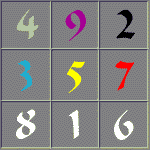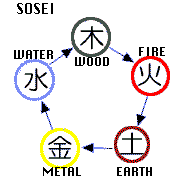
| |
The five planet names come from the traditional "five natural elements" theory in China, which, combined with "dark-light"(dualism) theory, forms the basis to understand nature and deduce guidelines therefrom for human activities.
Dualism theory is simple. It says that everything is made of plus and minus or light and dark. This idea is shared by many civilizations.
Five-natural-elements theory is more complicated. According to the theory, the world is made of five basic elements, i.e. wood, fire, earth, metal and water. Everything has these five elements, for instance, direction, time, season, color, taste, smell, sense and sound. These five elements were also attributed to the then known five planets, which were thought to dominate the fate of mortals.
The relations between the five elements are explained as good and smooth ("sosei" in Japanese) or competitive and unfriendly ("sokoku"). These positive and negative relations of the five natural elements decide the relations of the things to which the character of five elements are attributed.
In China many additional aspects have been introduced to interpret the universe. Those elements are, however, without exception, interpreted in light of "dark-light five-natural-elements theory". As the number of additional aspects increases and people start to combine different aspects, the interpretation of natural phenomena becomes more and more complicated.
Twelve elements (animals)
| mouse | ox | tiger | hare | dragon | snake | horse | sheep | monkey | cock | dog | pig |
| water | earth | wood | earth | fire | earth | metal | earth | water
|
| light | dark |
Juh-ni shi (Twelve elements)
You might often hear that Chinese use animals for the year names. For example, 1997 is the year of ox. This comes from the twelve elements theory. The twelve elements were originally conceived to name twelve months of the year and later twelve animals were adopted as names of those elements.
The "light-dark five-natural-elements theory" was then applied to the twelve elements and years have their meanings accordingly. Likewise, directions, time, season and so on are allo
cated these twelve elements, i.e. animal names.
Jukkan (Ten elements)
Another important measure is "ten elements" which were originally the numbers to count days.
They were also given characteristics of 5 elements and dual elements.
Ten elements | wood | fire | earth | metal | water |
| light or elder | ki-no-e | hi-no-e | tsuchi-no-e | ka-no-e | mizu-no-e |
| dark or younger | ki-no-to | hi-no-to | tsuchi-no-to | ka-no-to | mizu-no-to |
These ten elements are combined with 12 elements (animals) and form a very important basis for measuring time, direction, destiny of a person and so on. But, as you might easily notice, the same thing, for example, direction or season, is given different meanings by different methods and therefore there are certain contradictions. These contradictions increase when we use more theories or methods which are explained later on.
When we combine 12 animals and 10 elements in sequence, we get 60 different combinations. Therefore, a year name returns every 60 years. This year 1997 is namely "hi-no-to ushi" (fire: younger brother(dark): ox). September 19, 1997 is the day of "ki-no-e ne" (wood: elder brother (light): mouse).
Every day or year has thus different meaning. The basic system is the same in China and Japan. However, many new and local variations are added in different regions, therefore sometimes the meanings are not the same. The number of birth in Japan, for instance, sharply dropped in 1966, because girls who are born in the year of "hi-no-e uma" (fire: elder brother (light): horse) are believed to kill husbands. The duplication of strong fire (horse is fire) element is the reason. I think this is only a superstition. However, many people are influenced. I hear, on the other hand, that in Chinese society the year of Dragon is appreciated and tiger is hated. Therefore, Singapore government had tremendous difficulties to accommodate children born in 1988 in the elementary school as the capacity didn't match the big number of dragon children.
Hakke ( eight signs )
The example left (light-dark-dark) means, for example, "stay, remain or immovable like mountain".
The eight signs were invented thousands of years ago in China and the authentic theory was written down in "I chin" nearly three thousands years ago. As you might easily imagine, each of the eight signs has its value in light of 5 elements and dualism. Also the eight signs are allocated to different stages of human life, direction, character, body part, month and so on, and the result or the divination is interpreted accordingly. This is the most popular way of divination in the Far East.
Nine stars
| nine stars | 1 white | 2 black | 3 blue | 4 green | 5 yellow | 6 white | 7 red | 8 white | 9 purple |
| 5 elements | water | earth | wood | soil | metal | soil | fire |
Kyu-sei jyutsu (nine stars theory)
Another important method is based on a magic square. The nine numbers of the magic square are called "nine stars" and each of the stars is given one of the 5 elements and 7 colors as well.
| Magic square |  |
They are also combined with 10 elements, 12 elements and 8 signs, and become complicated and somewhat mysterious.
The astrology using the 9 stars is called "kyu-sei jyutsu" (nine stars theory) and there are many variations thereof. Nine stars theory says that there are nine signs in the sky ( like zodiac signs ) and the nine stars change their places from one to another sign and the world changes accordingly. The nine signs are placed on a diagram similar to that of the magic square, one in the center, which is dominant over time and space, and 8 others surround the central sign. A star is identified for a person according to his birth year and the relations between his star and the present constellation decides his present luck.
Six days of the week
| Saki gachi | Tomo biki | Saki make | Butsu metsu | Tai an | Shakku |
| Morning good | Taking friends | Morning bad | Everything bad | Lucky for everything | Bad day |
Riku yo (six days of the week)
There are also another type of calendar elements which are popular and important for the daily life of Japanese. Its origin must be also in China, but the exact roots are not clear. Riku yo (six days of the week) is simply 6 days with different characteristics, which are automatically allocated according to the lunar calendar.
It became popular, because it survived the strict ban of Meiji government of all superstitious annotations to the calendar at the beginning of Meiji restoration, as Roku-yo was not much popular and the government oversaw it. The meanings of 6 days are as follows.
Though, there is no special theory for this 6 days, this is very popular in Japan. Especially on the day of "taian" many wedding ceremonies are held.
It must be avoided that a funeral takes place on "tomo biki" because friends of the dead would be taken away to the hell.September 19, 1997 is "Sen sho". Therefore, we should start with something in the morning ;-)
I have explained here the traditional theories in Japan to understand nature and accordingly to evaluate the activities of people and tell fortune. I cannot but help having impression that our traditional culture is almost the direct transplantation of Chinese culture.
(*) The contemporary Japanese are still very much influenced by Chinese traditional wisdom.
(*)"Feng Shui" (wind and water), the dominant system in the contemporary Chinese society especially in Hong Kong and Singapore, is also based on the traditional Chinese theories as I explained above.
However, the present popular methods for fortune telling in Japan are also more and more Europeanized. So, for example, European type horoscope becomes very popular and ladies magazines have pages dedicated to fortune telling according to zodiac signs.
Also new system for evaluating human characters and chemistry becomes popular.
Blood type, for example, is a new theory invented probably in Japan.
(**)
(**) According to the theory, different blood type has different character and the chemistry of a couple is determined by their combination of blood types.
Blood type and character
| blood type | A | B | O | AB |
|---|
| character | scrupulous and earnest | egocentric and imaginative | generous and loose | nervous and whimsical |
It seems that many need some irrational and superhuman oracles as guidelines for their decision what to do. I am personally not interested in these things.
However, it is not easy to get rid of the influence of all superstitions, especially when we have lost all rational hope ...
A drowning man will catch at a straw ;-p









